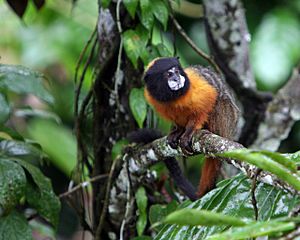Golden-mantled tamarin facts for kids
Quick facts for kids Golden-mantled tamarin |
|
|---|---|
 |
|
| Conservation status | |
| Scientific classification | |
| Genus: |
Leontocebus
|
| Species: |
tripartitus
|
 |
|
| Range of the Golden-mantled Saddle-back Tamarin | |
The golden-mantled tamarin (Leontocebus tripartitus) is a small monkey species found in South America. It lives in the Amazon rainforest in parts of Ecuador and Peru. These tamarins are known for their bright golden fur around their necks, which makes them stand out!
Contents
About the Golden-Mantled Tamarin
Where They Live
Golden-mantled tamarins are found in the upper Amazon rainforest. They live east of the Andes mountains in Ecuador. You can also find them in Northeast Peru, especially between the Rio Curaray and Rio Napo rivers.
What They Look Like
This tamarin is about 21.8 to 24 centimeters (8.6 to 9.4 inches) long from its nose to the start of its tail. Its tail is even longer, measuring 31.6 to 34.1 centimeters (12.4 to 13.4 inches). Their ears are small, about 3.1 to 3.2 centimeters (1.2 to 1.3 inches) long.
Their head is black, and they have a black collar of fur under their throat. The area around their nose, called the muzzle, is usually pure white. A bright golden or creamy ruff of fur sits on their neck, making a sharp contrast with their black head. Their belly and chest are orange. Like all tamarins, their long tail cannot grab things. They have large eyes that face forward. Both male and female tamarins look alike. They have strong canine teeth and claw-like nails on all their fingers and toes, except for their thumbs.
Tamarin Behavior and Daily Life
Golden-mantled tamarins spend most of their time in trees. They are active during the day, moving through the lower parts of the forest. They walk and leap on all fours, mainly on small branches. Leaping is their main way to cross gaps between trees.
They usually look for food between 4 and 10 meters (13 to 33 feet) above the ground. Their diet mainly includes fruit, nectar, and insects. They also eat gum from tree holes, sometimes even holes made by tiny pygmy marmosets. Because they are small and digest food quickly, tamarins need to eat food that is rich in nutrients and energy.
They drink water that collects on leaves, in flower cups, or in tree hollows. They lap it up with their tongues. They can also lick dew or moisture from their hands after dipping them in water. Unlike many other monkeys, tamarins do not suck up liquids or hold things to their mouths to drink. Young tamarins can suckle, but this ability goes away after they stop drinking milk. During the dry season, when food is scarce, they become less active and spend more time together in groups.
How Tamarins Communicate
Tamarins use many ways to communicate with each other, including special smells. These smells are part of their "chemosignalling" behaviors. They often rub special glands on their bodies (like those near their private parts or on their chest) onto things in their environment. This is called scent-marking. They also use their urine to leave scent marks. Sometimes, they even mark the bodies of other tamarins in their group. These scent marks help them share information about themselves and their territory.
Reproduction and Life Cycle
Tamarins live in small family groups, usually with four to nine members. They have interesting ways of reproducing. Females typically give birth to twins. In each group, only one female, usually the strongest or "dominant" one, will have babies. The dominant female's body produces hormones that stop the other females in the group from being able to have babies. Groups often have multiple males and females that mate with each other.
Pregnancy lasts about 140 days. Tamarin families are very involved in raising their babies. Other group members, including the males, help carry the newborns from their very first day. Babies start eating solid food and stop drinking milk when they are about 9 to 13 weeks old. At this age, they often get food by sharing or even by taking it from others.
When they reach the "juvenile" stage (around 4 to 7 months old), twin tamarins, especially those of the same sex, might have small "fights" to figure out who is stronger or more important. The "sub-adult" stage begins at 9 to 14 months. At this point, the young tamarin looks and is almost the same size as an adult. They reach sexual maturity at the "adult" stage, which starts between 12 and 21 months old. However, they usually don't start having babies until they are older.
Conservation Status
In 2008, experts looked at the golden-mantled tamarin's situation. They listed it as "Near Threatened" on the IUCN Red List. This means that their numbers are expected to drop by about 25% over the next 18 years. The main reason for this concern is deforestation, which is the cutting down of forests.
The forests where these tamarins live along the Rio Yasuni in Ecuador are very remote. So far, human activities have not affected them much, except for small camps set up for petroleum (oil) exploration. However, because there is oil in this region, a new highway called the Pompeya-Iro highway is being built. This road is a big worry for the future of these forests and the animals, like the golden-mantled tamarin, that live there.
See also
 In Spanish: Chichico de manto dorado para niños
In Spanish: Chichico de manto dorado para niños


